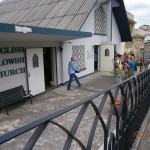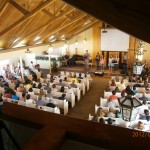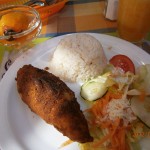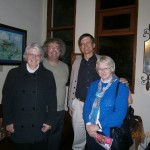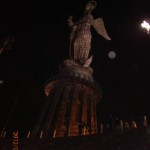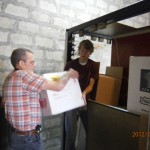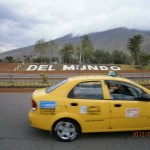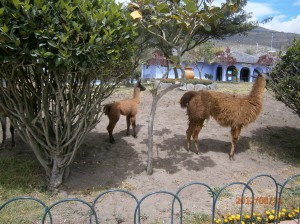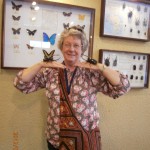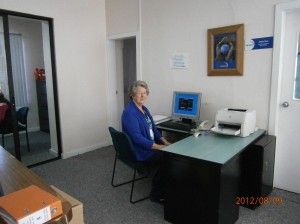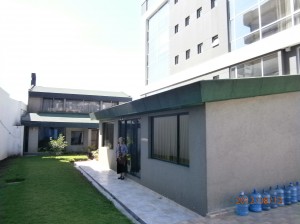KC is an abbreviated form of the word keratoconus. Keratoconus is a progressive disease in which the normally round cornea thins and begins to bulge into a cone-like shape. This cone shape deflects light as it enters the eye on its way to the light-sensitive retina causing distorted vision. Keratoconus can occur in one or both eyes. I have it in both eyes.
I don’t remember when I first heard the word keratoconus. It just seems as though that word has always been a part of my family’s vocabulary. You see my sister was diagnosed with keratoconus when I was only 6 or 7 years old.
I remember how sad everyone seemed to be because of the difficulty she had with her vision. She got her first pair of contact lenses in 1958. They were those old fashioned hard kind. I remember her having such a hard time getting used to those things. Her eyes watered, hurt and she squinted a lot. Finally, my parents took her to a different ophthalmologist. Her contacts were not fitting properly and she had abrasions on her cornea. A new fitting helped her a lot, but her eyes were always squinty.
When I was about 9 years old, I got my first pair of glasses. I never wore them much because they didn’t help. I remember hearing people talk about seeing individual leaves on the trees, etc. but I never noticed any difference. I do remember the school nurse always scolding me because I usually forgot my glasses and she said that I would see better if I did wear them. I was a good girl, so I wore them. When I was about 14, the doctor began talking about contact lenses for me. I refused, because I remembered what my sister went through. Finally, someone convinced me that I would be able to see better with contacts, so I agreed to try them. In 1966, I got my first pair of hard contacts. I adapted to them rather easily. I followed the doctor’s instructions to a “T†and I did fine. I also threw away my glasses. I could finally see!
I lost my first contact lens about 5 months later when I went with my father to check out a prairie fire that looked like it could be threatening our property (this was in Colorado where I grew up). I climbed up on the running board of the pickup and the wind just whisked it right out of my eye. Was I ever sad! After that we carried insurance for awhile and I also had a spare pair, but I only lost one other during my years at home, so we dropped the insurance. The other contact I lost, I dropped on the floor and couldn’t find it. A few days later my mother found it stuck on the bottom of the toilet bowl. It had bounced on the floor and hit the toilet just right to stick.
KC didn’t slow me down much during high school and college . During my high school years, I played basketball, volleyball and other sports. I loved basketball the most. I made 3-pointers before they gave 3 points! That was my favorite shot. I also excelled at ping-pong. I practiced a lot. At college, after I beat a few boys and the girl who was considered the best, no one would play with me any more. They didn’t want to get beat! I practiced enough to learn how to accommodate for my vision. I could still see the ball and had good reflexes.
After my sweetheart and I married, we went to the island of Bonaire to live. We were missionaries with a missionary radio station, broadcasting God’s Word around the world. Bonaire was where I lost another lens. The water was beautiful. One could just look into it and see the beautiful white sand. So, of course, I wanted to go snorkeling and in order to see when I snorkeled, I had to wear my contacts. I was putting on the snorkel and mask when the snorkel swung around and hit me in the eye. I was standing in the beautiful, warm, clear Caribbean when my lens popped out never to be seen again. I did have a spare pair.
Later we moved to South Africa. Fortunately, I took a spare pair of contacts with me to that country, not knowing what I might find there. I also took a lot of bottles of solutions and cleaners — enough for three years. Good thing I did. Eventually, I was able to occasionally find solutions in Johannesburg and Durban. I did find a doctor in downtown Johannesburg who was recommended as a possible fitter. My friend and I took the train from Roodepoort where we lived, to Johannesburg and then walked to the building where this eye doctor was. I did not get contacts to fit there because of the “strange†fitting my eyes took. It was a nice trip in spite of not finding someone to fit my contacts. We went shopping and had “tea†in one of the department stores. I was disappointed that I was not able to find someone to care for my eyes, but I was not desperate to get new lenses, I was trying to locate a doctor just in case the need arose. I never did find a ophthalmologist in South Africa.
After about three years in South Africa, we moved to Swaziland, Africa. This little third world country is beautiful and the people are friendly. It is dry and dusty, just as Bonaire and Colorado are. No eye doctors there at all. My eyes did fairly well during our 18 years in Africa. I did manage to get my eyes examined every three years while we were back in the US. I needed new lenses every time. Sometimes my eyes would begin to give me trouble before the three years was over. That was tough. I think it seemed to be associated with having children. The last two years before we left Swaziland, an American optometrist came to set up a clinic in Swaziland. He loved trying to fit my eyes. He never did, but he collected all my old lenses and enjoyed looking at my eyes and trying various things. When the electricity went off, he had a sign outside the window he would use to check vision and he would hold lenses in front of my eye to see if they would help or not. He wished he had equipment for fitting KC eyes and so did I.
We liked to go camping for vacation, and sometimes it was kind of rough camping. I would boil water or get water from the restrooms and have it beside my sleeping bag, so I could wash and put in my contacts first thing. I sometimes would have to have Larry guide me to the bathrooms because I didn’t want to put my lenses in right away. It was a challenge sometimes, but I never did get any eye infections from using the water in Africa or from being stingy with the solutions by using the soaking solution more than one day. I only washed my lenses in the morning. I must have been taught to do it that way with the old hard lenses. Now we are supposed to clean them in the evening after we take them out.
My sister continued to have difficulties with her eyes. She loved to sew and had four wonderful children to sew for. It got to the point where she could not see to sew or do many of the things she longed to do. A cornea transplant was scheduled. She did have the transplant in 1978. Tragically, the man who gave the donor cornea was a trapper and had, unknown to the doctors, died from rabies. My sister had begun to see with her transplanted eye better than she had for a long time. Within weeks she began have horrible headaches and in a short amount of time God took her home. She left four young children and a husband who loved her. The youngest child was three years old.
My eyes continued to worsen, but I looked at it more as an inconvenience than any thing. I continued to need regular changes in my lenses. In 1986, I let my ophthalmologist convince me that rigid gas permeable lenses would be much better than the old hard ones. I had resisted changing them three and a half years before because I figured that the others were working fine and I didn’t want to mess with something new. If it ain’t broke, don’t fix it attitude. Those new RGP lenses were like feathers on my eyes. When he put one in my eye there in his office, I just sighed. It was wonderful! I was sold! We finally returned to America to stay in 1989. We stayed in Colorado for a short time where I saw my old ophthalmologist. We were not there long enough for me to be fitted for my new contacts so he gave me some prednisone drops to help me tolerate my contacts until I could find a new doctor. The Hunt was on.
In Indiana, I called optometrists. I called ophthalmologists. If I couldn’t find anyone who knew what keratoconus was, I checked them off my list. I finally found an optometrist about 25 miles away. He did fit me with a new lens after making me go without for about 6 weeks. It didn’t help any to go without and I told him it wouldn’t, but he had to try. He was very sympathetic. He patted me on the knee and called me honey with a sad look on his face. He wanted to send me to an ophthalmologist to see if I would be a good candidate for a transplant. I told him I wasn’t ready for that yet and I’d probably have to see an ophthalmologist again when I needed a transplant so why waste the time and the money. I didn’t go. I never went back after I got my lenses. It took too long to get fitted and I didn’t like his “poor you†attitude.
I have also had doctors, and nurses tell me that I should have backup glasses. They have tried. They have even tried after I have gone without wearing contacts for an extended period of time and glasses alone don’t work. They make absolutely no difference in my vision. The doctors I appreciate the most are the ones who can tell that my eyes are bad enough that going without contacts is not going to improve anything. It did allow abrasions to heal, but did not cause any positive change in my vision or eyes. The only plus side of going without contacts is that no dust or mess is visible to my eye. I miss a lot on a good day anyway!
Although, I had reached the point where I could no longer drive at night, KC continued to be more of an annoyance than a real problem. I could still work around it and do what I wanted.
I went to a local ophthalmologist for my next check up. They didn’t have a contact lens fitter, but were getting one. I waited for him and he was wonderful. He looked at my eyes and said.â€We’ll start with what you have and work from there.†He always scheduled me last on his list and stayed late to do as much for me as he could. I kept him and his staff late many time. I am so thankful for him and for his wife who allows him to do this. He bought me 10 years before I needed a transplant. The ophthalmologist in that office has seen me at very odd hours. He has come in at 10:00 at night when my lens flipped over and stuck to the inside top of my eye and removed it for me. He actually couldn’t find it himself and thought I had lost it, but it was there and he persevered until he found it and got it out. He never charged me a dime! He has also seen me on Saturday when I was having rejection problems after my transplant and did not charge and he was not the one who did the surgery. I am blessed with wonderful doctors.
My eye continued to worsen. I wore glasses over my contacts to help with the astigmatism and, of course, my age made reading glasses inevitable. I was working with children with learning disabilities and was having difficulties distinguishing letters, reading upside down and seeing across the room. It was quite annoying. The children thought it very funny but were quite understanding. They knew what it was like to have disabilities. I could still drive, but not at night especially not if it was rainy. The glare and star bursts from all the droplets of water made it impossible. It is still very difficult even after the transplant.
Three years ago, I could no longer tolerate a contact lens on my right eye. I had been going to the eye doctor every week for months as he tried to help me. He had me go without that lens for a couple of months. During that time we took a trip and on my return three weeks later my eye had deteriorated considerably. An appointment was made with a cornea specialist for the next week. After seeing him, my transplant surgery was scheduled for three weeks later.
I was a little apprehensive about a transplant. I knew that what happened to my sister was the exception, but it did bring home the dangers involved in any surgery. The list of complications that the nurse reads to you is very unlikely to happen, but when someone you know dies as a result of a surgery, you know that those complications, no matter how unlikely, can happen.
August, 2004, I received my new cornea. I was a little disappointed with the immediate results, but it was better than it had been. I felt as though I had been hit in the eye with a baseball and had a beautiful little bruise under my eye. I was so pleased. The pain I had been suffering for months was gone. I could read stop signs! After 14 months, the stitches were taken out. Not much change in vision. New glasses helped some. I was scheduled to have some relaxing incisions made and cataract surgery. That was rather painless, some discomfort, but not bad. My vision improved dramatically. My eye lid began to droop badly after all the surgeries and was impairing my vision. I had eye lid surgery to improve that. I had “natural†eye shadow for awhile after that. The eye lid surgery helped a lot. Later the ophthalmologist did some more “relaxing†incisions in his office. They also helped a lot. My vision is now 20/30 in that eye. It is better than my left eye with its contact lens. (No, I am not considering a transplant in the left eye. It is doing fine with the lens. “If it ain’t broke, don’t fix itâ€). I still need glasses to help with the astigmatism and for reading, but I am so blessed. I was off work for 5 days after my surgery. I never stopped driving in the daytime. I spent my recovery time working on the computer. I have had no light sensitivity since my surgery. I did have light sensitivity before the surgery.
I have had rejection problems and am using prednisone drops once a day for the rest of my life. I also have problems with dry eye and have to use drops for that and keep a humidifier running and take supplements for dry eye. I can see better at night, but still don’t drive much after dark. I see better in the daytime and can read again. KC is still a nuisance, but not really life altering for me. I use larger print on the computer and make adjustments where needed. I am now able to read street signs without stopping the car somewhere and walking back to read it. I don’t remember when I was last able to do that. Things still look a little fuzzy, but are so much better. I do make odd mistakes in reading when I can’t tell for sure what the letters are. But it is so much better.
I just returned from a check up with the ophthalmologist and my eye is doing fine. The omega 3 capsules I am taking and the artificial tears are improving my problem with dry eye. I am sure that the added humidity of summer weather has also helped. My vision is good. I am so grateful.
As I think of my life with KC, I am reminded of a young girl at the school where I work. She completely lost her eyesight in high school. She learned how to make her way through the halls and graduated with very good grades. What really impressed me was that she was a cross-country runner. She did not let blindness rob her of her joy of running. She found a helper to run with her. She held onto her helper and ran. She never came in last. To me she is an example of trust and making the best of something that would get lessor people down and depressed. I am so thankful for my sight and the improvement my transplant has made.
I must end this being thankful for the excellent doctors God put in my way to care for my eyes. I believe that I could not have had better. I am also thankful for the family who allowed the corneas of their loved one to be used to give someone else sight. It was a very humbling experience to think that because someone died, I can see. Words do not come that would adequately express my thanks to that family, but I do thank them from the bottom of my heart.
Although I am not blind, the words below written by Fanny Crosby express somewhat my feelings are about KC.
Oh, what a happy soul I am,
Although I cannot see,
I am resolved that in this world
Contented I will be.
How many blessings I enjoy
That other people don’t
To weep and sigh because I’m blind.
